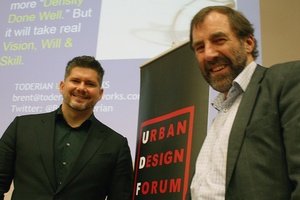Vancouver at the vanguard

Wellington caught up with Auckland in the urban conversation stakes on Friday 17 October with the first part of its inaugural Wellington Conversations series starring staunch Vancouverite and density advocate, Brent Toderian.
Toderian’s leading theme - which he also took to Christchurch last week and is speaking about in Auckland, Monday 20 October - is that cities need a lot more “density done well”.
Given Vancouver’s status as a world-leader in urbanism and his own role as the city’s former chief planner for six years between 2006 and 2012, Toderian knows well of what he speaks.
His pick for the eight most UN-helpful words in the English language: “We could never do that in our city!”
Noting all the accolades accorded Vancouver, Toderian wryly comments that “once you get to be an ‘IT’ city, you can be ranked for just about anything”.
The reality is that the economically successful density managed in Vancouver has rested on a bedrock of good planning and design - “something smart and clever cities understand”.
Toderian is confident that the tide is turning for density. “The math and data.. and the demographics are on our side” he says, citing the phenomenally large predisposition of both the 18-35 and baby boomer generations to “flood the urban environment”.
In arriving at a “complete downtown” approach - coupled with a complete city and region - the elements that have been garnering success in Vancouver have included:
- Evolving from “doing the wrong thing, to doing the wrong thing better, to doing the right thing”
- Positioning density differently and beating drums like the advantages that come from “the power of nearness”
- Having public spaces that entice people to make a trade-off in having less private space
- Emphasising walking and “sticky streets” at every level - horizontal and vertical - with architecture playing a key part as a catalyst for “walkability gains”
- Designing streets through the lens of placemaking as much as mobility
- Nurturing the growth of a ubiquitous, if at times publicly perplexing, cycling culture by insisting on separated bike lanes, full stop.
- Shifting mindsets about transit corridors to “corridors of urbanism”
- Embracing worldwide trends like car sharing
Toderian freely admits that Vancouver’s dream ride was hugely eased by resistance decades ago that prevented freeway creep within the city. Showing a recent protest poster titled ‘Attack Of The 50 Foot Condos’ he also acknowledges that Vancouver isn’t immune to its own version of “density wars”.
Additionally he warns that the key challenge of current times is “doing suburbia differently”, adding “I don’t rate any place until I’ve seen the suburbs… ultimately (our) survival, our failure or not, is based on how nimble our suburbs are”.
“We certainly don’t want to rest on our laurels (in British Columbia)… be that the need to diversify into more adventurous architecture for our tower and podium typology, or doing even more to provide the amenities and diversity that make density enjoyable”.
Epilogue: New Zealand density
Toderian’s muted criticism of the attitude to density in New Zealand is to call it “rather timid”.
Speaking in Wellington he praised the trolley buses - without knowing they are having the plug pulled on them - while openly chiding Mayor Celia Wade-Brown for the absence of a chief planner on the council staff.
The Mayor wasn’t off the hook the following day on similar issues of governance and city management either when attending the resurgent Wellington Civic Trust’s urban development seminar, “Avenues and oases in the capital”, held at the same venue.
As occurred the night before, a large audience of concerned Wellington citizens illustrated that any aversion to high density is either being mis-reported or simply misplaced simply because New Zealand lacks sufficient examples.
Echoing Brent Toderian, panelist and stakeholder specialist Isabella Cawthorn supported the notion that all it takes for density to be done well is real vision, will and skill. “Here in Wellington we don’t even need to be crazy innovative, just roughly right”.
October is certainly a full-on time for surfacing city planning issues, in what New Zealand’s newly rejuvenated Urban Design Forum (UDF) is dubbing an unofficial ‘Urban Design Month’.
This is because of the number of convergent events this month, culminating in the hosting of Prof Kathryn Moore, President of IFLA - the International Federation of Landscape Architects - at an Auckland Conversation on 30 October, and the UDF’s own standalone workshop on Papakainga Development as part of the NZ Institute of Surveyors Conference “Beyond the Boundaries” in New Plymouth on 31 October.









